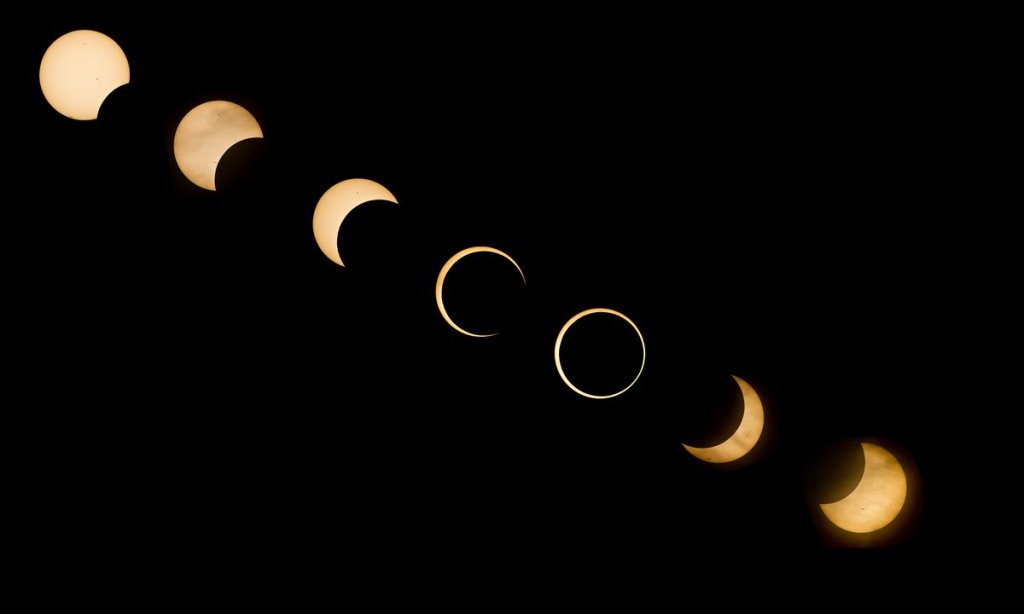
The 5 main stages of October’s annular solar eclipse explained (Image Credit: Space.com)
The sun will appear as a blazing ring of fire in the sky over the Americas on Saturday, Oct.14, as an annular eclipse sweeps over the continent.
The eclipse will be visible from several states in the U.S., beginning at 09:13 PDT (12:13 p.m. EDT, 1613 GMT) in Oregon then moving across Nevada, Utah, New Mexico, and then Texas. The event will also be visible from some areas of California, Idaho, Colorado, and Arizona before it passes into the Gulf of Mexico.
After this, the eclipse will pass over Mexico, Guatemala, Belize, Honduras, Nicaragua, Costa Rica, Panama, Colombia, and Brazil. The annular eclipse of 2023 will end at sunset over the Atlantic Ocean.
Related: Which U.S. states will October’s ‘ring of fire’ solar eclipse be visible from?
NASA has released an interactive map of the annular eclipse, which space enthusiasts can use to track the ring of fire, and Space has summarized how observers not on the path of the event watch the annular solar eclipse online. What can eclipse watchers expect to see, and how will the annular eclipse progress from region to region?
Don’t be in the dark about this eclipse
There are three major types of eclipse. A total solar eclipse happens when the moon completely blocks the face of the sun. An annular solar eclipse occurs when the moon is further from Earth and obscures only part of the solar disk. finally, a partial solar eclipse is when the Earth, moon, and sun are not perfectly aligned, so the lunar disk only covers part of our star.
The event on Oct. 14 is an annular eclipse, meaning that the moon is far from the Earth, and therefore, the sun will not be completely obscured, leaving a fiery golden ring shining around the dark lunar disk. This will happen gradually, with the annular eclipse bookmarked by partial solar eclipse phases.
What are the stages of the annular solar eclipse?
Stage 1: First contact

During the first stage of the eclipse, the moon will begin to pass in front of the sun, beginning a partial solar eclipse. During this stage, the dark disk of the moon will make the sun appear as if a progressively larger bite has been taken out of its illuminated face
Stage 2: Second contact
Happening at around 1 hour and 20 minutes after first contact begins, this marks the beginning of the annular eclipse or the annularity. The moon has moved fully in front of the sun and light from the star begins to form a “ring of fire” around the moon. One interesting phenomenon that occurs at this stage is “Baily’s Beads,” which take the shape of droplets of light in an arc around the edge of the moon. Bailey’s beads are caused by the uneven edge of the moon, which is punctuated by mountains and valleys through which sunlight streams as the sun is being covered.
Stage 3: Maximum eclipse

At this point, the moon completely covers the center of the sun’s disk with the glowing ring of fire. The duration of the annularity depends on where on the eclipse’s path it is viewed from but is usually between 4 and 5 minutes. For instance, eclipse watchers at Oregon Dunes, Oregon, will see the sun as a ring of fire for around 4 minutes and 29 seconds, while sky watchers in Corpus Christi, Texas, will get to see it for around 4 minutes and 52 seconds.
Stage 4: Third contact
The moon will start to move away from the disk of the sun, thus ending the annularity and starting the second partial eclipse period. Skywatchers will again get the opportunity to spot Baily’s Beads along the edge of the moon.
Stage 5: Fourth contact
Finally, the moon moves away from the disk of the sun, no longer partially eclipsing it and ending the 2023 annular eclipse.
If you intend to view any of these stages, the most important thing to consider is how to safely view it. Looking at the sun without adequate protection at any time is harmful to the eyes, so eclipse watchers should take precautions on Saturday.
Sunglasses, regardless of how dark they are, can’t protect the eyes from the effect of the sun, so specialized eclipse glasses made from safe solar filter materials will be needed. If skywatchers intend to watch the event with a telescope, special filters will be needed to make this a safe viewing experience.
Our how to observe the sun safely guide tells you everything you need to know about safe solar observations.
One simple way to view the annular eclipse is to watch it via the image of the sun projected onto a sheet of card. This can be done by poking a small hole in a card with a pencil point and facing it toward the sun. A second card should be held around three or four feet behind the first in its shadow. This allows the projected image of the sun to be seen on the second card.
Following the 2023 annular eclipse, skywatchers in the U.S. will get the opportunity to see a total solar eclipse on April 8, 2024, as it sweeps over North America, darkening skies over Mexico, the U.S., and Canada.





